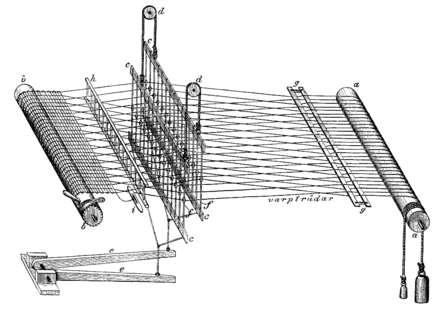Weber sheet

The weaver's reed , also called reed , comb or reed , is part of a loom . It has a comb-shaped or better ladder-shaped structure: a multitude of thin leaves are located between two parallel strips or metal profiles. The warp threads run through the slits between the leaves .
construction
The leaflets are tied into the parallel strips and fastened with pitch (pitch collar) or, as is more common nowadays for machines, made of lead or tin cast or epoxy resin. These leaves are mostly made of metal today. In the past, they also consisted of (reed) cane and are also referred to as "pipes" in some older literature, hence the name reed. The warp threads run through the narrow spaces between the leaves.
The density of the reed determines the density of the fabric, but it must also be based on the thread size and the thread material. The width of the reed determines the maximum fabric width depending on the loom. The height of the leaf determines the maximum "jump height" of the shed.
function
In the loom , the warp threads run from the warp beam (a) to the fabric beam (b). The vertical movements of the shafts (c) spread the warp threads so that a shed is created between them. The weft thread is inserted between the warp threads through the weft with the shooter (i), also called the shuttle .
The weaver sheet (h) is located between the shafts and the goods tree. After each shot, the weaver blade is moved towards the goods tree. The weaver blade presses the newly inserted weft thread against the already finished fabric and presses the threads together.
See also
Individual evidence
- ↑ Technology of Textile Fibers, Volume IV, Part 2 B. Cotton and curtain fabrics, edited by Dr. RO Herzog, Berlin, Julius Springer, 1933. (Section D.5., P. 18)
- ↑ Brockhaus' Kleines Konversations-Lexikon, 5th edition, Volume 2. Leipzig 1911, p. 959, online at www.zeno.org
